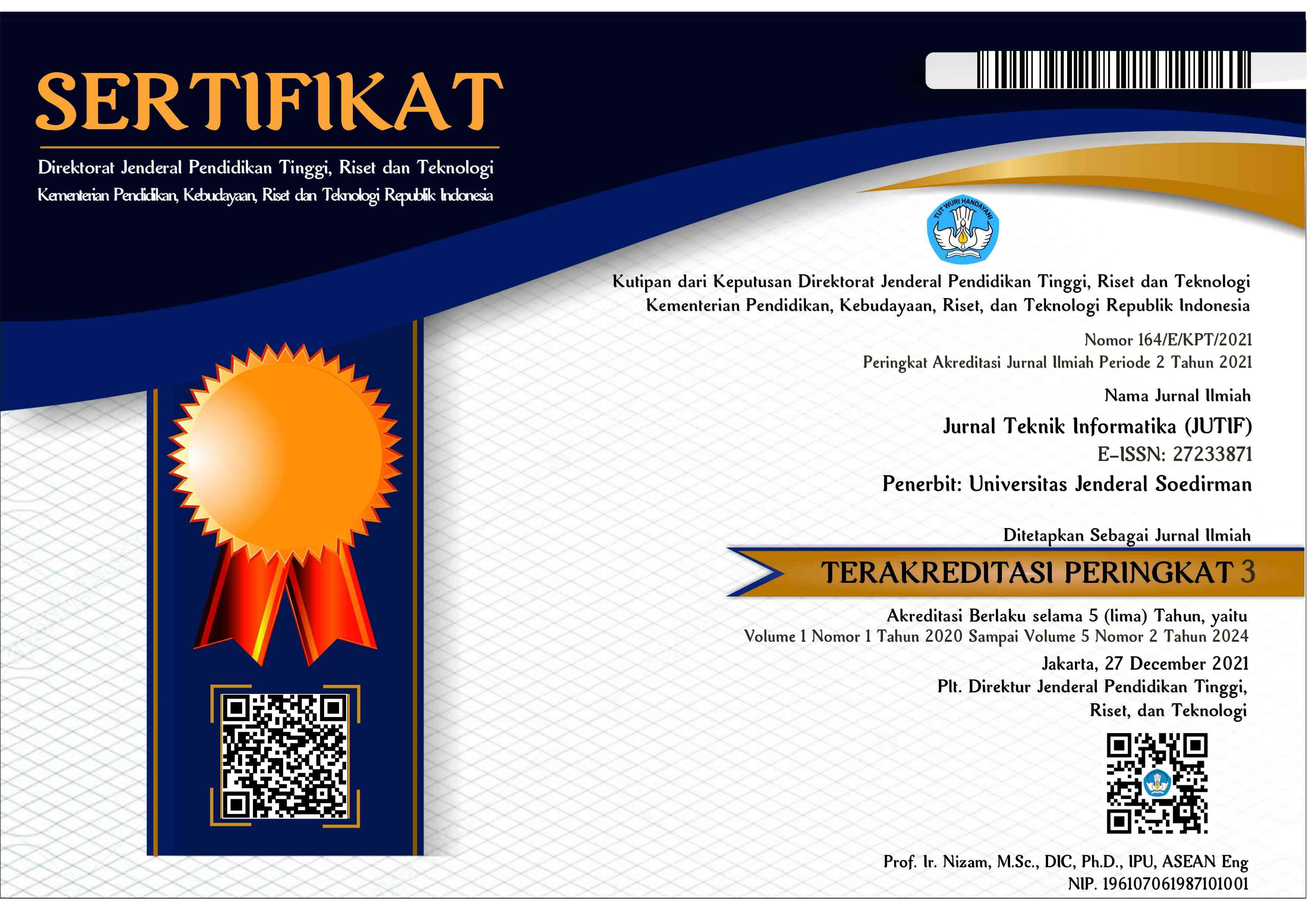DOCKER-BASED MONOLITHIC AND MICROSERVICES ARCHITECTURE PERFORMANCE COMPARISON
Abstract
Most developers still use the monolithic architecture, where all components of an application are combined into one integrated system, so each part depends on other components. The monolithic architecture has weaknesses, such as when a failure occurs in one component, all parts cannot be executed because each component relies on one other component. Microservices can be a solution to this, considering that in the microservices architecture, each element or service is created and put separately, so when a failure occurs in one component, other components will not be affected and can still run normally. This research aims to determine the implementation and performance comparison between monolithic architecture and microservices Architecture in the Agreeculture Market web app. Agreeculture Market is a web application that aims to facilitate the transaction process of agricultural commodities and make it easier for agricultural commodity producers to market their products. The measurement method used to measure the performance of both architectures is load testing using JMeter and performance tools from task manager and comparing the response time, throughput, disk usage, CPU usage, and memory usage of both used architectures. With two measurement schemes with Docker and without Docker, the result of this research is a performance comparison between the two architectures, where the backend application Agreeculture Market, which uses microservices architecture with Docker and API gateway, performs better than the monolithic architecture version. Conversely, the monolithic architecture performs better than the microservices architecture in the scheme without Docker and API gateway.
Downloads
References
M. E. Gortney et al., “Visualizing Microservice Architecture in the Dynamic Perspective: A Systematic Mapping Study,” IEEE Access, vol. 10. Institute of Electrical and Electronics Engineers Inc., pp. 119999–120012, 2022. doi: 10.1109/ACCESS.2022.3221130.
C. V. Dave, “Microservices Software Architecture: A Review,” Int J Res Appl Sci Eng Technol, vol. 9, no. 11, pp. 1494–1496, Nov. 2021, doi: 10.22214/ijraset.2021.39036.
J. A. Rasheedh and S. Saradha, “Design and Development of Resilient Microservices Architecture for Cloud Based Applications using Hybrid Design Patterns,” Indian Journal of Computer Science and Engineering, vol. 13, no. 2, pp. 365–378, Mar. 2022, doi: 10.21817/indjcse/2022/v13i2/221302067.
N. Singh et al., “Load balancing and service discovery using Docker Swarm for microservice based big data applications,” Journal of Cloud Computing, vol. 12, no. 1, Dec. 2023, doi: 10.1186/s13677-022-00358-7.
K. Gos and W. Zabierowski, “The Comparison of Microservice and Monolithic Architecture,” in International Conference on Perspective Technologies and Methods in MEMS Design, 2020, pp. 150–153. doi: 10.1109/MEMSTECH49584.2020.9109514.
A. Bucchiarone et al., “From Monolithic to Microservices An Experience Report from the Banking Domain,” 2018.
J. Xiang, “Microservices-based Dating Platform,” 2021. [Online]. Available: https://martinfowler.com/articles/
J. Ferdinand, A. Syahrina, and A. Musnansyah, “PERANCANGAN ARSITEKTUR PERANGKAT LUNAK MICROSERVICES PADA APLIKASI OPEN LIBRARY UNIVERSITAS TELKOM MENGGUNAKAN gRPC,” TELKATIKA, vol. 1, no. 2, 2022.
G. Blinowski, A. Ojdowska, and A. Przybylek, “Monolithic vs. Microservice Architecture: A Performance and Scalability Evaluation,” IEEE Access, vol. 10, pp. 20357–20374, 2022, doi: 10.1109/ACCESS.2022.3152803.
F. Ponce Mella, G. Márquez, H. Astudillo, and F. Ponce, “Migrating from monolithic architecture to microservices: A Rapid Review BaaS-SE Blockchain as a Service for Stock Exchange View project TacPat4SS-Empirical evaluation of tactics and patterns for building secure systems View project Migrating from monolithic architecture to microservices: A Rapid Review,” 2019. [Online]. Available: https://www.researchgate.net/publication/335716451
I. Braun, M. Hoffmann, and R. Mörseburg, IMPLEMENTATION OF A WEB-BASED AUDIENCE RESPONSE SYSTEM AS MICROSERVICE APPLICATION VS. MONOLITHIC APPLICATION. 2019.
Óbudai Egyetem, IEEE Hungary Section, M. IEEE Systems, Hungarian Fuzzy Association, and Institute of Electrical and Electronics Engineers, 18th IEEE International Symposium on Computational Intelligence and Informatics : proceedings : 2018 November 21-22, Budapest.
S. Jhingran and N. Rakesh, “PERFORMANCE ANALYSIS OF MICROSERVICES BEHAVIOR IN CLOUD VS CONTAINERIZED DOMAIN BASED ON CPU UTILIZATION,” Journal of Data Acquisition and Processing, vol. 38, no. 2, p. 3221, doi: 10.5281/zenodo.777159.
P. Sharad Salunkhe, “Microservices vs Monolithic Architecture: Load Testing in AWS on ReactJS Web Application for Performance MSc Research Project Programme Name.”
N. Goncalves, D. Faustino, A. R. Silva, and M. Portela, “Monolith Modularization towards Microservices: Refactoring and Performance Trade-offs,” in Proceedings - 2021 IEEE 18th International Conference on Software Architecture Companion, ICSA-C 2021, Institute of Electrical and Electronics Engineers Inc., Mar. 2021, pp. 54–61. doi: 10.1109/ICSA-C52384.2021.00015.
D. Demashov, “Efficiency Evaluation of Node.js Web-Server Frameworks,” 2019.
Copyright (c) 2024 Deni Panji Dirgantara, Dana Sulistyo Kusumo, Rio Guntur Utomo

This work is licensed under a Creative Commons Attribution 4.0 International License.




























